|
As mentioned in my last post this fly has become a staple in my Smallmouth arsenal. It is a rare, very rare occasion that you will see me on a float with out this rigged on one of my three rods. My buddy Ed started using this pattern several years ago after talking to William Heresniak of Eastern Trophy Fly Fishing. This pattern comes form the mind of Chuck Craft, arguably one of the most accomplished Smallmouth fly anglers in the country. Crayfish patterns are kind of like Stonefly patterns in that it is hard to get the look you are going for without getting too detailed. This typically adds tying steps and time to the fly. When tying bottom crawling type flies you already know going in you are going to loose some. It is a tough pill to swallow when you take 30 / 45 minutes to tie a fly and than hang it on a rock and break it off 5 minutes after you tied it on. The Clawdad hits on all of the key features of an impressionistic Crayfish pattern, is relatively fast to tie, and just plain catches BIG smallmouth! Could this be the perfect Smallmouth fly? Check out the Step By Step below, tie up a few on your own and see for yourself. Recipe; Hook; Mustad R749672 2X heavy 4 XL signature hook (this is a size #4) Thread; Tyer's choice, color to match body (I am using Veevus 6/0) Eyes; Medium lead dumbbell eyes Body; Medium Chenille, color to match tail Claws; Eastern Trophy Fly Fishing Clawdad tail size to match hook, color to match fly Legs; Medium round rubber legs To purchase everything you need to tie click HERE I am using the Norvise Large Inline jaw and Norvise Magnum Hubs to tie this pattern. Disclaimer; I vary a little from the original dressing. This is a matter of personal preference in some of the things I like to see in the pattern and is not as any form of dis-respect to Chuck or William. I believe confidence in a fly is very important, while I dont think I have deviated much from the original, I do know if I like the way a fly looks I will fish it more effectively. In capable hands, both flies will produce equally as well. 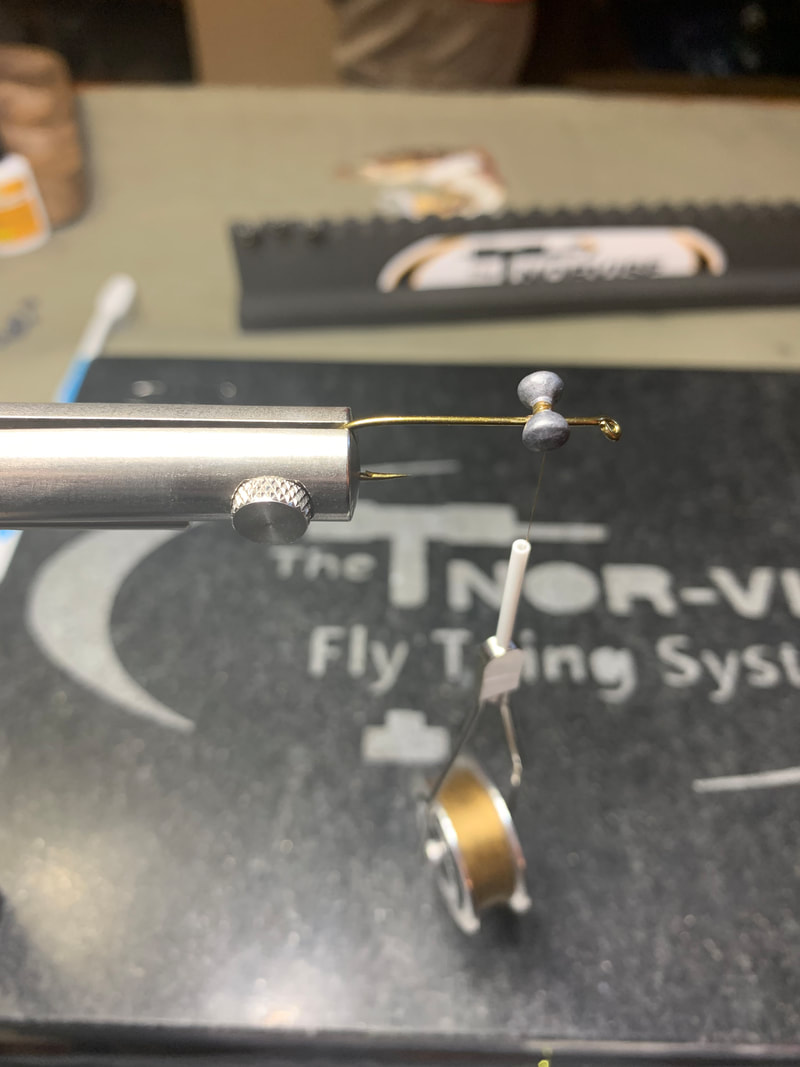 Next tie in a set of medium dumbbell eyes in the same fashion you would if you were tying a Clouser Minnow. Couple of tips; 1) you can use the black coated eyes or paint the eyes afterward to match the color of the body. 2) I will use the length of the dumbell to measure back from the hook eye to know where to tie them in. 3) ABSOLUTELY glue, epoxy or light cure the eyes after tying in.  Strip the fuzzy part of the chenille off of the core and tie the core in right behind the eyes. Here I have "folded in the core". Folding in is where you tie the core down with several tight wraps, fold the tag end back over the thread wraps and wrap back over top of the core. Doing it this way makes it virtually impossible to pull out. 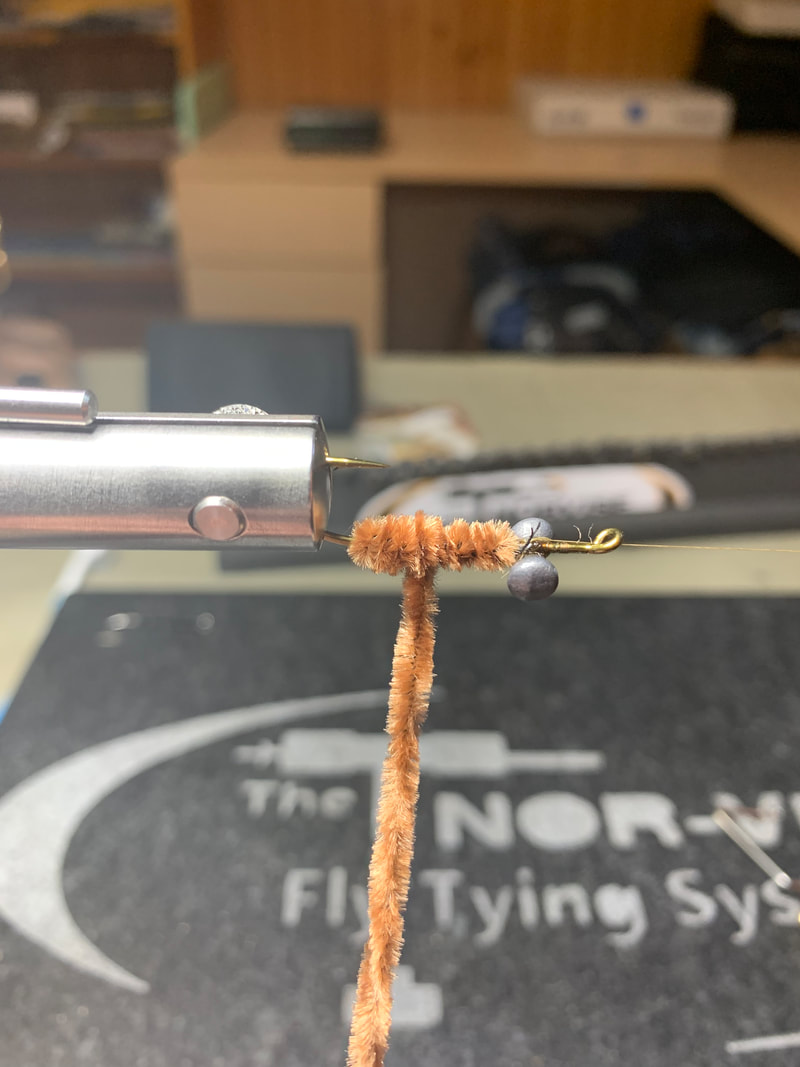 Here is the first tweak from the original. first lay down a little Flex Cement on the hook shank. Next wrap (or spin if using the Norvise) the chenille around the hook shank from the back of the eyes to just under the barb of the hook moving front to back. Next, wrap the chenille up on top of itself, making the body double thick, for 3 wraps moving back to front. Stop here.  Wrap your thread back to the point where the chenille is hanging and secure it with several tight turns of thread. Carefully remove the fly from the jaws and put the tail on. The tails are pre punched with a hole and will easily slide over the hook point. Return the fly back to the vise. Position the tail so it is straight and on top of the chenille on the inside of the hook bend. secure the tag end of the tail with several thread wraps advancing the thread up to the eye of the hook. A Dab of Flex cement will do you well right where the tail meets the chenille.  Now wrap the remaining chenille over the tag end of the tail and forward to the eye of the hook. Figure "8" around the dumbbell eyes to make sure they are covered. Tie off the chenille, clip and build a nice thread head. Clip your thread from the hook. You can see this double wrap technique gives a little fuller body, it also acts as a support for the tail and will keep it from sliding around the bend of the hook. I believe the fly swims better this way. To fish the fly I like to throw it on an intermediate or a sink tip line on a short (4' max) 12# leader. Use a non slip mono loop to connect the fly, this will allow the fly to move and the action won't be effected by the heavy tippet. Cast out, let it sink and crawl or hop it back. 2016 was the best year I can remember in 30+ years of fishing our Smallmouth rivers. Myself and Ed landed well over 2 dozen fish that year over 18", several were over 20 and my personal best ever on a fly a true "blackjack" pictured below. ALL of these were landed on the Clawdad! Till next time...
Tight lines - Tim Most of my friends locally that know me know that I am a self proclaimed Smallmouth nut! They are my favorite fish and they are tailor made for fly fishing. Myself, Tyler and my friends spend many hours chasing Smallies each Summer. We have our rods, reels, and watercraft dialed in. We each carry several rods with different lines so we can cover the entire water column from top to bottom and we are very familiar with the rivers that we float. What does all of this mean? Well, we are fortunate enough to land several 18 to 20 inch Smallmouth each year. Our Smallmouth game is tight, and we take pride in that. I always say if you were to look into my working fly boxes you would probably be extremely underwhelmed. You may expect to see box after box with hundreds of different patterns in every color under the rainbow. While I do love tying flies, I love catching fish even more. and when I am all on the water it is all about the fish and catching them! While we are constantly experimenting, tweaking, and coming up with some new patterns. What follows are my core 5 Smallmouth flies. I call these "American Express Flies' because you don't leave home without them (you will have to be over 40 to get that reference) and you can bet if you see me on the river one (or 3) of these will be tied on my tippet. We are full into summer fishing right now (the heat index is 108 as I type this) so I thought for the next couple of blog posts I could do a series of my 5 favorite Smallmouth patterns followed by a step-by-step tutorial in the coming weeks of each pattern. If you are a Smallmouth Junkie like me this is a great opportunity to fill your boxes with some proven producers. Here we go... The ClawdadIf you told me I could only ever fish one fly for Smallmouth this may be the one. This fly has accounted for more 20+" fish in the last 8 years than any other fly I fish. Spawned from the mind of Chuck Craft and available through William Heresnaik in materials or whole at Eastern Trophies Fly Fishing this could possibly be the perfect Smallmouth fly. I typically ALWAYS have one of these rigged and fish it on the bottom on an intermediate or sinking line. Brown (or moccasin) is my go to color, we have also done well on olive and black. I tie mine a little bit different than the original dressing, just a few little tweaks. They probably don't really help and the original is probably best left alone. Fishing is 90% confidence and if I feel more confident in the pattern, I am going to fish it more effectively. PoppersAny Serious Smallmouth angler worth his salt loves fishing poppers. The fishing is very visual and the takes can be explosive. We have used several popper styles over the years, some tied and some purchased. we have settled on these 2 as our favorites. The Boogle Bug. A friend from Virginia turned me on to these several years ago. We got to talking about Smallmouth fishing and he said in his Virginian accent "you ever fish Boogles"? You have to say with the accent or it kind of looses the presentation. I had no idea what he was talking about. Boogles are a hard face popper tied with a hackle skirt and rubber legs. They are very durable and catch a ton of fish. The one thing I noticed is the hard face poppers, especially the Boogles have a higher pitch pop when you strip them. Something I believe the fish really key on at times. If interested check them out here. A few years ago the Flymen company came out with the Double Barrel popper heads. As soon as I saw them I knew I had to try them. The dual sound chambers and the semi-soft popping face gave us a sound that was very familiar. Remember the old Arbogast Hula Popper? The big gaudy, weird looking Bass hard bait? We fished these all the time as kids and they produced a deep, hollow pop it seemed the fish couldn't resist. Well, the Flymen Double Barrel popping heads come the closest to reproducing that sound. We quickly put these heads into some of our current designs (both mine and some of my friends) and the results have been fantastic. O'Neill's Controlled ChaosThis type of fly is really more of a tying style rather than a pattern. Mike Schultz of Schultz Outfitters came up with a great pattern Called a Swinging D. This was the first time I saw a foam popper head turned around backwards to create a diver type of fly. The Swinging D is a GREAT fly, it takes a long time to tie with a lot of steps. Many people, including me, have taken Mike's pattern and tweaked it a bit for various reasons, for me it was strictly tying time. This is probably my favorite pattern in the bunch and, like the Clawdad you will be hard pressed to see me without one if these rigged up. Throw this on an intermediate or a type 2 sink tip on a short leader. The foam head want's to naturally float the fly up and the sink tip wants to pull it down. This self imposed Tug -of War creates an action that is incredible! This pattern is ever changing and here are a few of the variations I have used over the past few years. I am currently working on a all Synthetic version of the fly using some of the great new brushes that have hit the market recently. Like I said, this is more of a basic platform pattern so have fun with it. The Feather Game ChangerAbout 8 years ago a fly hit the market that was truly a revolution in the fly tying world. Blane Chocklett's Game Changer is truly an innovation in the fly tying world. More of a platform for tying multiple patterns the Game changer is available in many variations today. My favorite is the Feather Game Changer. MUCH faster to tie that the original (not fast mind you, they still take 45+ minutes to tie) the best thing about this version is the taper is in the materials, there is little to no trimming. Now you are seeing variations with spun deer hair heads, popper heads and the like making this pattern very versatile. Check out one of the great videos on how to tie this great pattern by searching Feather Game Changer. Shumaker's Shimmering MinnowBrian Shumaker is one of the premier guides on Pennsylvania's Susquehanna River. You may have heard of the Susquehanna before as it is where the famous Clouser Minnow was born. The Shimmering Minnow is a bit of a wide body baitfish pattern, a perfect match for the juvenile Shad the Bass in my area enjoy. Easy to tie and fishy as any fly out there it is easy to see why this pattern has become a staple in my buddy Ed's Fly box. You can tie this in Multiple colors, we prefer the pearl / grey version. To date I believe the shimmering Minnow has landed something like 40 different species from Smallmouth on the Susquehanna to Steelhead in Erie, it is just a great all around fly. Well, there you have it, my top 5 Smallmouth flies. Stay tuned in the coming weeks for tutorials on how to tie all of these great patterns. Till next time...
Tight lines - Tim |
Archives
June 2024
Categories
All
|



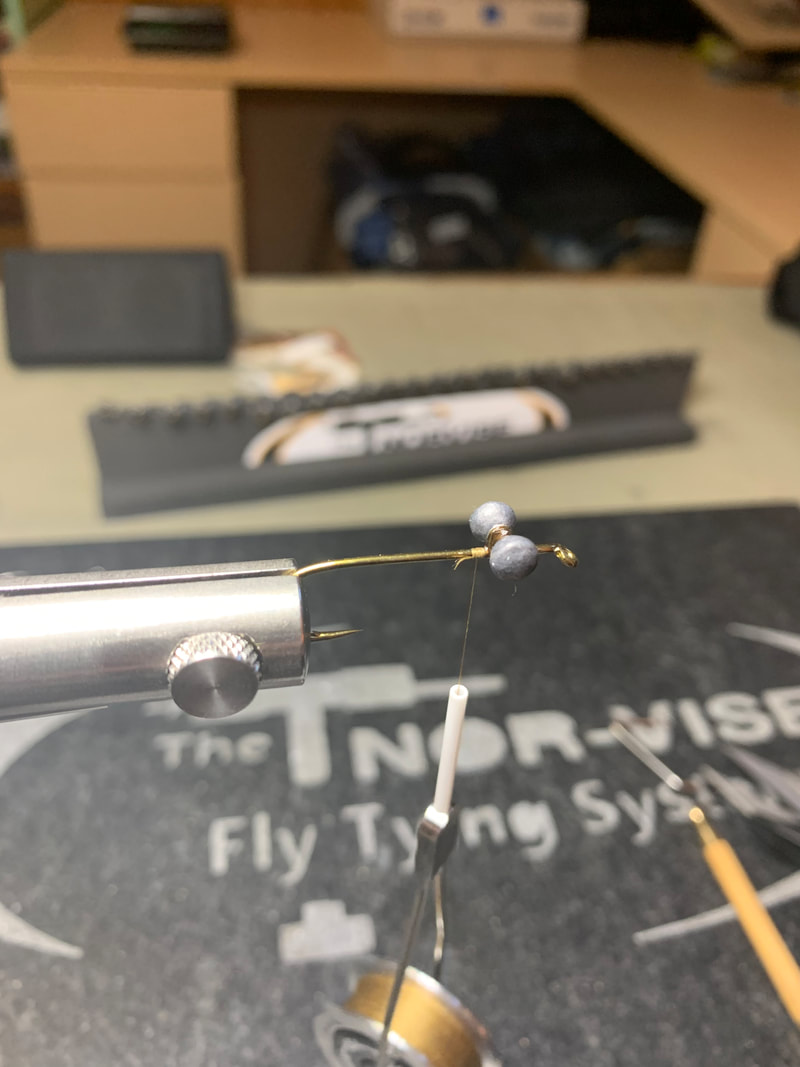



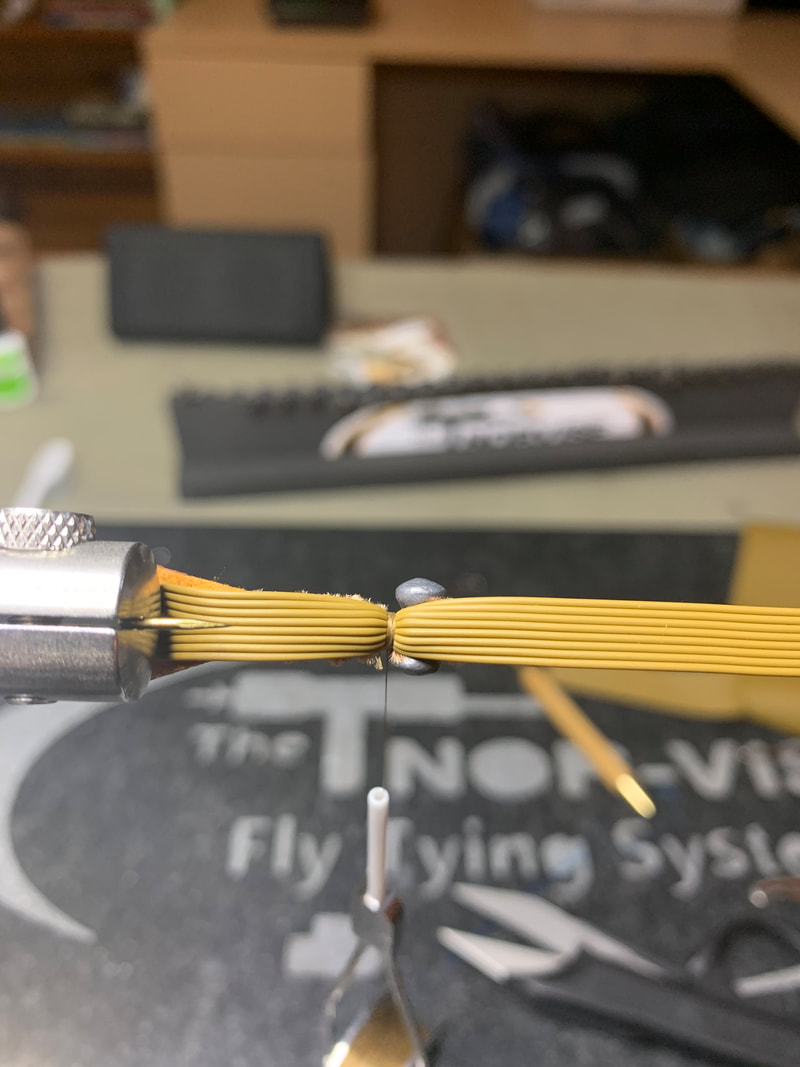

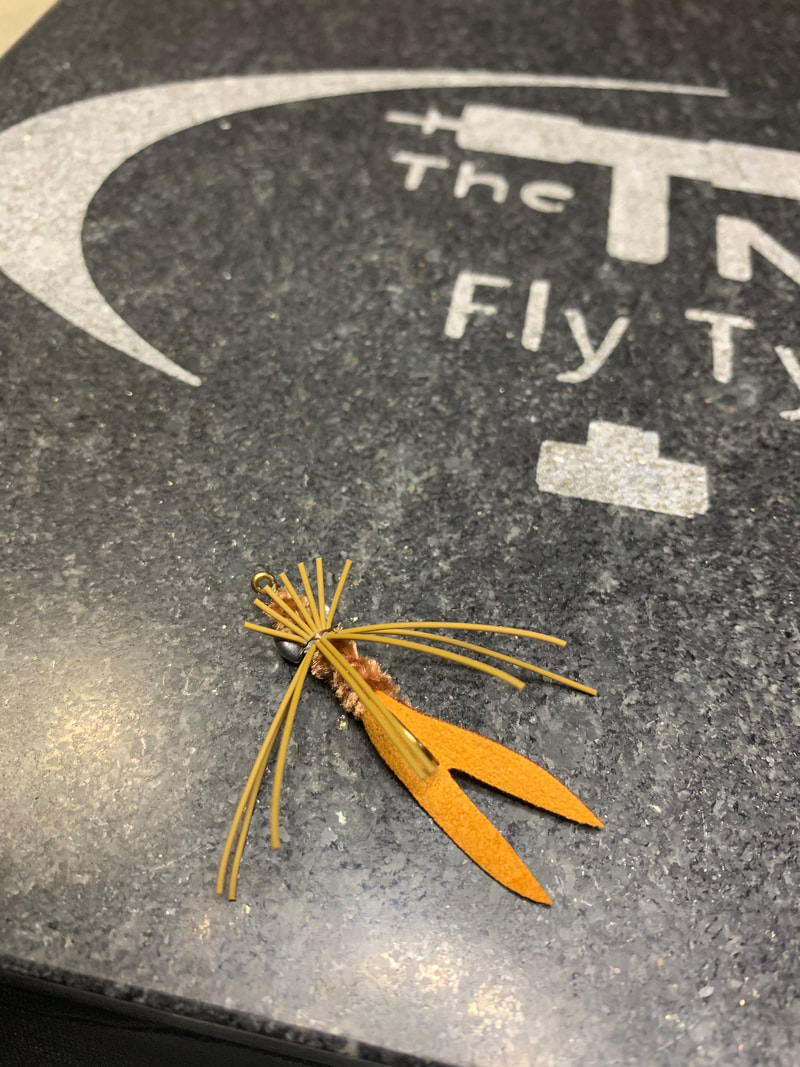















 RSS Feed
RSS Feed
